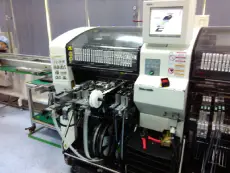

Panasonic’s Precision Labeling Solution for the 3C Industry
Catalog
Challenges with Traditional Labeling EquipmentPanasonic’s High-Performance 3C Labeling SolutionFunction Block Program LibraryConclusionIn today’s rapidly advancing world of industrial automation, labeling machines have become indispensable equipment in manufacturing lines. For the 3C industry (computers, communications, and consumer electronics), labeling is a critical step in ensuring quality and enabling traceability of products. A labeling machine can automatically and precisely apply labels to products, improving production efficiency and reducing errors associated with manual handling.

Panasonic label feeder
However, traditional labeling machines face significant challenges when addressing the high precision, speed, and flexibility requirements of the 3C sector. With a vast variety of products, small sizes, and fast turnover, the 3C industry demands greater accuracy and adaptability from labeling systems. Traditional equipment often encounters bottlenecks in the following areas:
Challenges with Traditional Labeling Equipment
- Limited Flexibility for Diverse Production: Traditional machines are not capable of handling both synchronized equal-spacing and unsynchronized irregular-spacing labeling simultaneously. This requires the use of multiple machines, increasing production costs.
- Low Labeling Precision: Traditional models lack compensation mechanisms, which means the labeling precision is limited by the quality of incoming materials. If there are slight variations or irregularities in the materials, the final labeling may not meet the required precision, affecting product quality.
- Rough or Wrinkled Labeling: The use of constant tension control during material winding can lead to increased torque on the outer layers as the roll diameter grows. This results in wrinkles and uneven surfaces, negatively impacting product quality and production efficiency.
Panasonic’s High-Performance 3C Labeling Solution
To address these challenges, Panasonic has introduced a high-performance labeling machine specifically designed for the 3C industry. The solution offers a smart and innovative approach to meet the diverse needs of modern production lines. Key features include:
Feature 1: Modular Control System
- Single Axis Control Module: Ensures smooth and efficient process flow.
- Centralized Scheduling Module: Monitors and controls the overall production process in real-time.
- Production Monitoring Module: Offers real-time tracking of production status.
- Modular Architecture: A flexible and modular design allows for easy addition of specialized modules, such as synchronized labeling, asynchronous labeling, visual detection and alarm systems, and compensation modules.
This modular approach enhances the machine’s functionality and flexibility, enabling manufacturers to easily adjust the system to meet varying production requirements.
Feature 2: High Precision Labeling with Synchronized/Asynchronous Color Mark Compensation Algorithm
- Synchronized Labeling: With a detection sensor that compares the positions of two color marks, the system uses a synchronized color mark compensation algorithm to achieve high precision. At a bottom film interval of 60 mm, the machine can reach labeling speeds of up to 50 meters per minute.
- Asynchronous Labeling: The system is also capable of handling asynchronous labeling, ensuring flexibility for a variety of production needs.
Feature 3: Taper Control Algorithm for Smooth Winding
- The taper control algorithm adjusts the surface tension during the winding process to maintain optimal values, ensuring balanced central force and stable internal structure. This controls the winding to be "loose on the outside, tight on the inside," resulting in smoother and more consistent winding.
As a result, the winding quality improves by 20%, the defect rate drops to 1.6%, and the end-face flatness increases by 50%.
Function Block Program Library
Panasonic provides a comprehensive Function Block program library that includes core algorithms like the taper control and smooth label feeding mechanisms. This library helps manufacturers meet complex requirements and flexible production scenarios with ease. By offering localized solutions tailored to Chinese manufacturers, Panasonic enables faster development cycles, facilitating seamless integration of sophisticated control features and enhancing production capabilities.
Conclusion
With its high precision, flexibility, stability, and data traceability, Panasonic’s 3C labeling machine has become a reliable partner for the 3C industry. Whether dealing with large-scale production or small-batch diversified needs, this solution handles it all with ease, improving production efficiency and helping manufacturers achieve high-quality smart production. Panasonic continues to be a leader in providing innovative solutions for modern manufacturing demands, ensuring that 3C labeling processes are both efficient and precise.
Subscribe to JMBom Electronics !













